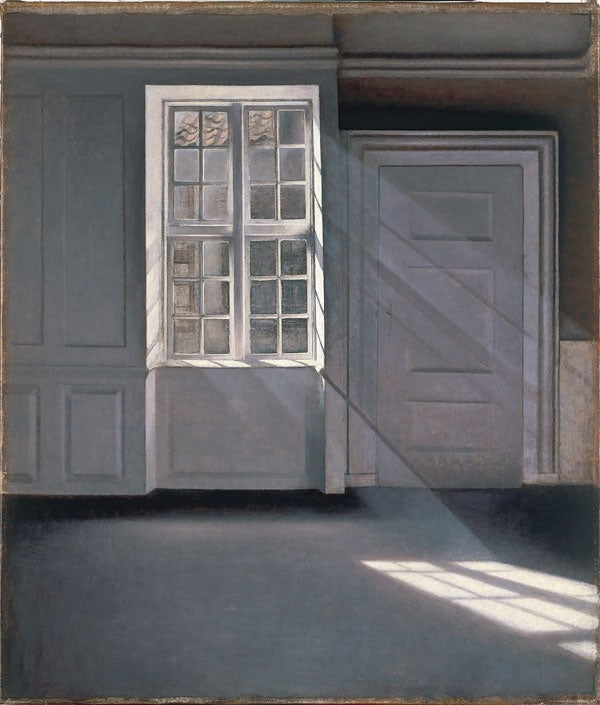Great Works: Sunbeams or Sunshine. Dust Motes Dancing in the Sunbeams 1900 (70 x 59 cm), Vilhelm Hammershoi
Ordrupgaard, Copenhagen

Your support helps us to tell the story
From reproductive rights to climate change to Big Tech, The Independent is on the ground when the story is developing. Whether it's investigating the financials of Elon Musk's pro-Trump PAC or producing our latest documentary, 'The A Word', which shines a light on the American women fighting for reproductive rights, we know how important it is to parse out the facts from the messaging.
At such a critical moment in US history, we need reporters on the ground. Your donation allows us to keep sending journalists to speak to both sides of the story.
The Independent is trusted by Americans across the entire political spectrum. And unlike many other quality news outlets, we choose not to lock Americans out of our reporting and analysis with paywalls. We believe quality journalism should be available to everyone, paid for by those who can afford it.
Your support makes all the difference.Seldom has a painting been so gloriously full of its own emptiness. It is one of a number of interiors that the Danish painter Vilhelm Hammershoi based on his own first-floor apartment in the Christianshavn district of Copenhagen. It is also what we might call – to borrow a familiar phrase – a "window painting", but it does not share one of the principal characteristics of the window painting. The window is not the frame of the painting, offering some scene of wonderment.
Here the windowscape is something of a trick or a feint. It draws our eye towards it as the source of light, but then it almost rebuffs us. We see a little – a tiled roof, for example – but in fact it is too little to be truly satisfying. And what of the room itself? It seems to be self-enclosed, of itself; the door looks too firmly recessed, scarcely openable at all. It is all so spare and so bare. The window mouldings could scarcely be simpler. There is no decorative refinement here. There are no drapes and no furniture either. Nor is there the merest hint of human drama. The door seems to have the tiniest of tiny keys. The texture of the surface of the floor is not readable at all. It almost tends towards the smoothness of abstraction.
The drama of the painting consists first of all in the illuminated recess of the window itself, of something as evanescent as shafts of light, how they seem to pour through it on the diagonal, and the dust-choked sunbeams themselves, which are so beautifully caught – it is a spreading expanse of greyness, hatched into by light itself. The quality of the light is not rendered self-consciously – this is not an impressionist or a pointillist painting. It errs, if anything, on the side of dusty academicism. Hammershoi despised Impressionism and most other manifestations of the modern. And there is so little colour here. It is so low-keyed, so tonally neutral, always edging off to grey. Its narrow range of colours puts us in mind of the mature Morandi. This was often the case with paintings by Hammershoi – to such an extent, in fact, that one acquaintance speculated that the artist might be colour-blind. This was not in fact true.
How different it is from the great interiors of the Dutch Golden Age! Think of Vermeer and Pieter de Hooch. How full those rooms so often were with people, dogs, fabric, spilling vases of trumpeting blooms, window drapes, noise, luscious fabric, and often lubricious laughter. And yet Hammershoi did not always paint his own apartment in this way. At other times it was often much more studiedly populated with objects.
The apartment itself consisted principally of three long rooms, populated with his furniture, his books and in other interiors by Hammershoi we do see this things. He would often shift them about, making new arrangements for paintings. These rooms were his painting studio. And the furnishings we often see in these paintings were typical of a man who lived in comfortable bourgeois surroundings – a square piano, bibelots, paintings by artists of the Danish Golden Age, the previous generation to his own. He would paint this interior again and again, quite often with his wife in attendance. Most often she would have her back to the painter. She would therefore be completely inscrutable, and this is, in general, what we often think about the best of Hammershoi's interiors, that they are opaque in the extreme, psychologically inscrutable, seemingly bland, but in fact rather eerily disturbing.
But seldom quite as inscrutable as this one, which is not so much a picture of an interior as a portrait of a dark, silent psychological space, illuminated, all of a sudden, by a shaft of enlightenment. And it was all pure fabrication too. This was not in fact a quiet neighbourhood at all. Not when Hammershoi lived there. There were docks nearby. Ship's engines were being fabricated at the end of the street.
ABOUT THE ARTIST
Vilhelm Hammershoi (1864-1916) was the greatest of the Danish fin de siècle Symbolist painters. He specialised in haunting, ghostlyinterior scenes, which were occasionally inhabited by a woman who would be characteristically standing with her back to us.
Join our commenting forum
Join thought-provoking conversations, follow other Independent readers and see their replies
Comments